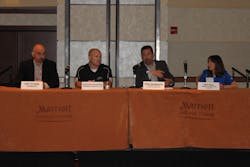Although equipment on the manufacturing floor typically still uses hardwired safety, the trend is to move away from a lot of wiring and enable easier commissioning, which can be done in part by integrating safety information onto the control network. “You want to reduce the number of networks in system,” notes Sari Germanos, technology marketing manager for the Ethernet Powerlink Standardization Group (EPSG).
Germanos was part of a panel discussion about industrial safety networks at The Automation Conference this week in Chicago. For some audience members, the idea of integrating safety into the main controls network seemed a scary one. But everything that would’ve been part of the separate safety network—wire break detection, short detection, etc.—is still part of the combined system, assured Joey Stubbs, North American representative of the EtherCAT Technology Group. “Everything that was in those older hardwired systems is still in there in the newer systems,” he said. “It’s just added all the benefit of wiring simplification. It cleans up the wiring, cleans up the system, and the faster response is a really good thing.”
Some expressed concern, wanting to know what’s required to make a system truly safe, and if it wouldn’t be better to keep the safety system completely isolated. In a way, though, even the safety system that’s integrated onto the control network is isolated, said Tina Hull, product engineer for safety at Omron Automation & Safety. “The safety PLC is its own CPU system,” she said. “It’s monitoring itself and not letting standard information in there.”
The other devices on the network don’t have access to the safety data, Stubbs explained. “You do have your own safety systems segregated; it’s just internal,” he said.
Stubbs pointed to the ability to intersperse safety devices with standard PLCs and non-safety drives as a big advantage. “If we put things on their own safety system, it’s kind of a step backwards from where we are now and where we’re headed to.”
The automotive industry has been a key adopter of the integrated network, according to Greg Richards, system engineer for Siemens Industry. “Automotive tends to be on the forefront of technology,” he said. Theatrical applications have been another early adopter, Stubbs added.
Simplifying cabling and wiring isn’t the only reason to integrate safety into the control network, panelists said. As Germanos pointed out, adding a safety CPU or safety PLC onto the network enables more flexibility in safe manufacturing. “A safety PLC can do things like slow the system down instead of stopping it,” he said, explaining that manufacturers could save considerable costs by bringing machine operation to a safe speed and letting the machine ramp back up gradually. “And the reaction time on a network system is much, much faster.”
Another benefit of adding safety to the main network is that configuration of the logic is typically done through a software interface, making reconfiguration quicker as well, Stubbs said. “You can make a configuration change in the software via controllers.”
Maintenance is easier too, according to Hull, because it’s easier to figure out what shut down a machine so that it can get up and running again. “These networking systems make that so much easier because now it’s integrating everything from the safety side and the motion side, even the vision side,” she said.
The other panelists agreed. “Having an integrated network gives you a big advantage because now you can debug your system very easily,” Germanos said.
“Having everything built into the system, the diagnostics are already there,” Richards added. “Uptime is what we want. When that machine’s down, the production manager is right there behind you. You certainly want to figure it out fast.”
And just because you have a dedicated safety network doesn’t guarantee that you’ve made that network safe. Richards, for example, said probably the No. 1 mistake he sees out in the field is people not shielding cables once they leave the control cabinet. Putting safety onto the control network, however, lets you simplify wiring constraints. “We can distribute that I/O; now I don’t have to worry about protecting that cable,” Richards said.
“One of the things that bothers me the most about safety is a lot of people buy the greatest safety devices,” Hull lamented, “and then they stick it on a standard PLC that isn’t certified for safety.” It only takes one weak link to shut down a system, she added.
“It’s impossible to make a system perfectly safe and perfectly affordable,” Germanos noted. “For the subsystems that are doing safety functions, your whole chain needs to be safe. How much of that you do and how much protection you do, it really is an art, not a science.”

